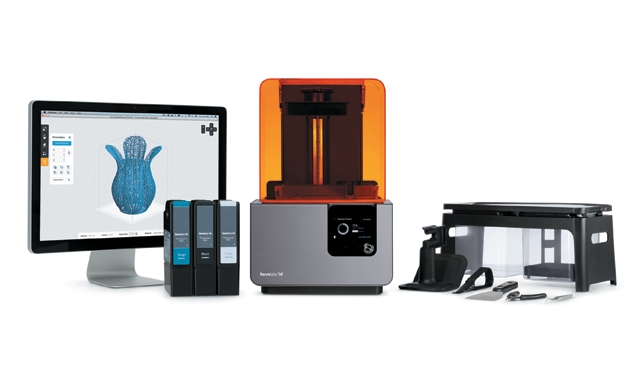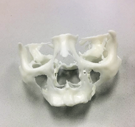Making 3D printing accessible for all labs
How the Formlabs Form 2 3D printer helped one lab achieve an ideal workflow-at an affordable price.

Near the end of last year, Robertson Dental Lab relied solely on their five milling units to create dental restorations. Nearly four months later, they are preparing to invest in an equal number of 3D printers. With three so far, they are well on their way.
Robertson Dental Lab, located in Lompoc, California, purchased a Formlabs Form 2 3D printer in December and has gotten two more since then.
Because it has completely changed their workflow, says general manager Paul Lamontagne, they plan to get two more soon for a total of five. At that point, the lab will have an equal number of 3D printers and milling units.
The Form 1, Form 2’s predecessor, is the world’s best-selling printer, so one can imagine the possibilities for the upgraded Form 2, especially at a sub-$4,000 price point. The Form 2 printer is $3,499, which makes it easier for a productivity-focused lab like Robertson Dental Lab to invest in a few.
Trending article: 5 workflows changed by 3D printing
“When we began to look at digital printers, which are expensive and can do a lot, we decided to stay with a lower-cost printer at a higher quality so we could have more printers and be more versatile,” says Lamontagne. “We knew that if we bought one printer, we would be tying up our work into that one printer. Even with a larger bill plate, we would be committing our work to one build plate. With the Form 2, we can run multiple cases at different times for less money. That gives us greater flexibility and greater throughput. We can use different products in different printers. It’s much more cost-effective.”
By incorporating three separate 3D printers into their workflow so far, the lab is able to use each printer for a different material.
“There are five materials we can use with Formlabs,” says Lamontagne. “For example, what we use for models is different than what we use for partial frames. One printer will use a certain material, another will use another material, and a third will have a different material. Once we add more, multiple printers will be using the same material. We’re able to fill the build plate, and when we have enough to fill the next build plate, we’ll start it afterward, cleaning and curing in between.”
While Lamontagne currently only uses the printer to print models and custom trays from impressions and digital scans, he is currently testing their efficiency with surgical guides and partial dentures. “They’re not in production yet, but we’re trying to decide if we’re going to use the Form 2 Printer for that,” Lamontagne says. “We might do surgical guides in the future, depending on how that affects the workflow.”
At the moment, Lamontagne’s lab outsources removables, but his team is looking at bringing that workflow into the lab. “We’re still in the phase of testing the designs and how we want to go about the process,” he says. “We’ll know by the end of April if we’re going to integrate.” He said the lab will “most likely” be integrating partial dentures into their workflow.
Continue to page two to read more...
When Lamontagne first purchased a 3D printer for his lab, it was just to try out 3D printing. “We didn’t have any 3D printers yet, but we wanted to convert over digitally,” he says. At the time, Robertson Dental Lab had five mills. “We purchased one Formlabs printer to see if it would give us the quality we were looking for,” he says. “Since then, we have purchased two more, for a total of three currently, and we’ll purchase two more at some point and have five total.”

“We’re going to be changing our workflow to do impression scanning on a regular basis now that we’re comfortable with the models we’re getting,” he says. “We’re working with our regular dentists. At present, we accept digital scans from offices. We produce model-less crowns. We print out a verification model from those digital scans, to make sure that the contacts and fit will fit in the mouth. It’s taking the digital scan to design the model so we can verify that it can go passively and accurately into the mouth.”
Lamontagne anticipates that having several Form 2 3D printers in his lab will increase their capacity for production, cut down their turnaround time and allow them to increase their volume with their current staff. “We see that as a very crucial piece to allow us to pivot into greater capacity,” he says.
That’s one way dental labs are trying to stay competitive in today’s market: by increasing their production without sacrificing quality or imposing a heavier burden on their staff. With 3D printing, they can do just that, while also seamlessly adding more tasks to the workflow.
“We are able to manufacture crowns in five days because we can accelerate the process with digital technology,” says Lamontagne. “We’re able to do 24-hour crowns because we don’t have a model process, we’re just printing from a digital scan. We cut our turnaround time to benefit our customers and increase our capacity.”
Related reading: Formlabs releases new biocompatible 3D printable resin
One of the most fascinating things Robertson Dental does with the Form 2 is print models of patients’ skulls to increase the analysis of the strength and structure of the orofacial complex. By having these models, dentists and technicians can more readily see the types of procedures that would work best for their patients.
“We also take CT scans and print out a replica of bone structure within the maxilla and mandible to assist oral surgery,” he says. They print the skull models to display an accurate reflection of what’s inside the mouth and skull and determine if there is enough bone structure for implants to be placed into the sinus.
The Form 2 printer has a larger build volume than the Form 1. A 250mW precision laser printer, the Form 2 delivers “big prints with spectacular detail,” according to the Formlabs website, as well as a new peel mechanism, wiper, and heated print tank, which makes it the most advanced desktop 3D printer ever created.
Product Bites – January 19, 2024
January 19th 2024Product Bites makes sure you don't miss the next innovation for your practice. This week's Product Bites podcast features new launches from Adravision, Formlabs, Owandy Radiology, Henry Schein Orthodontics, Dental Creations, and Dental Blue Box. [5 Minutes]